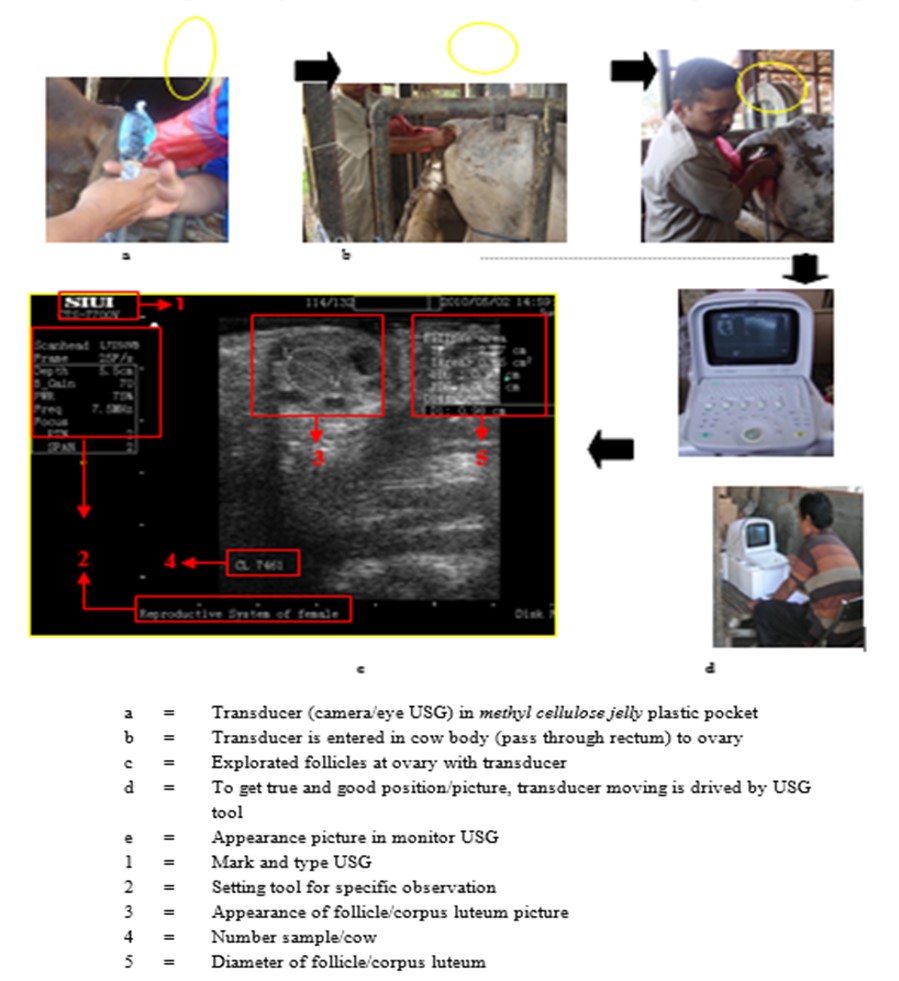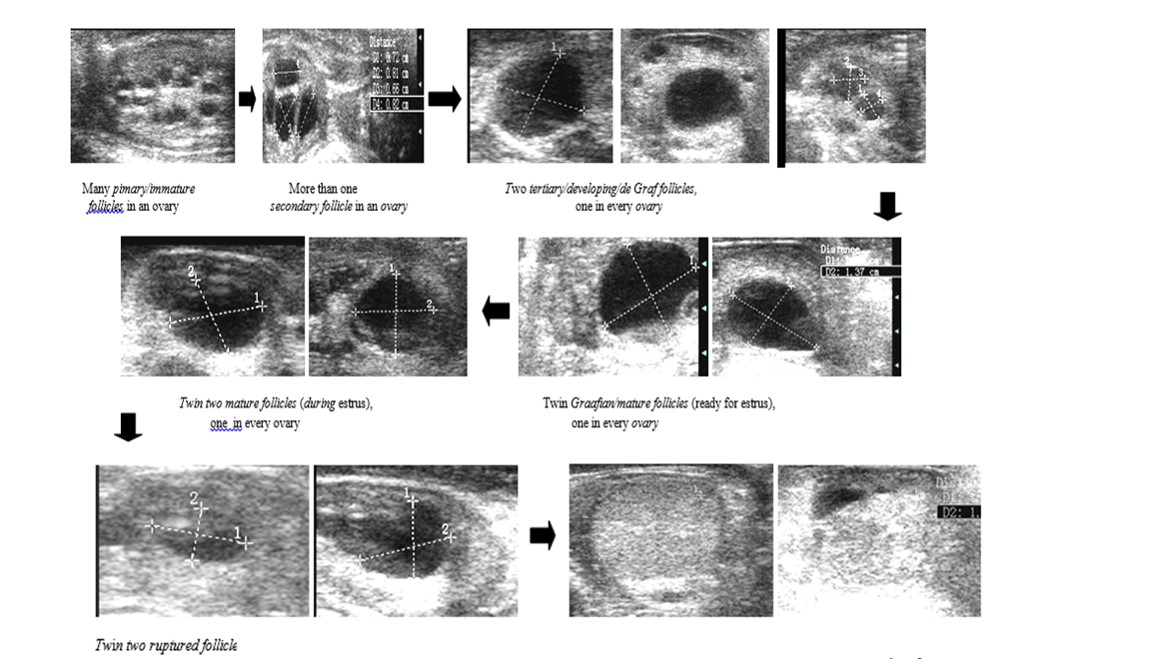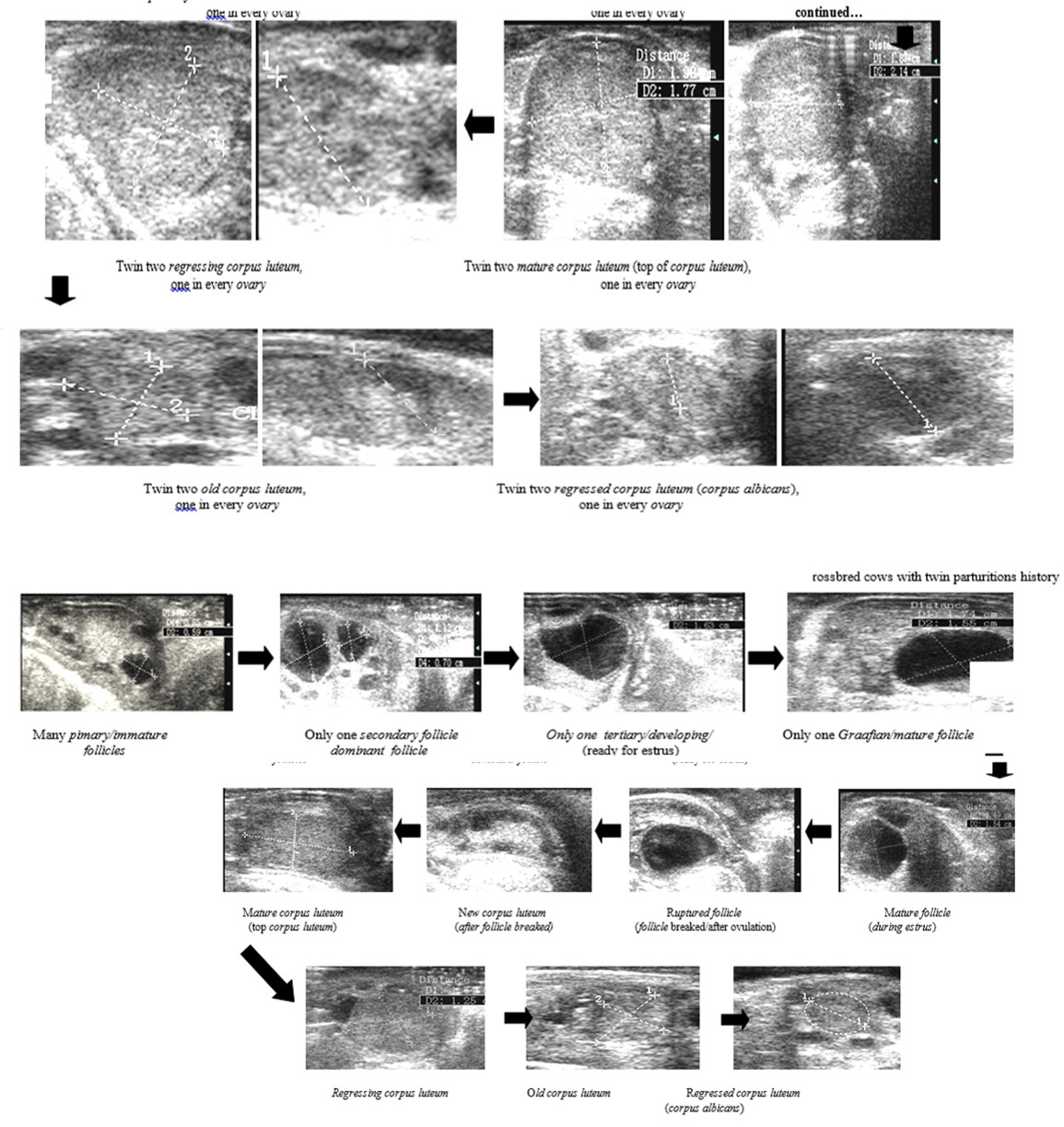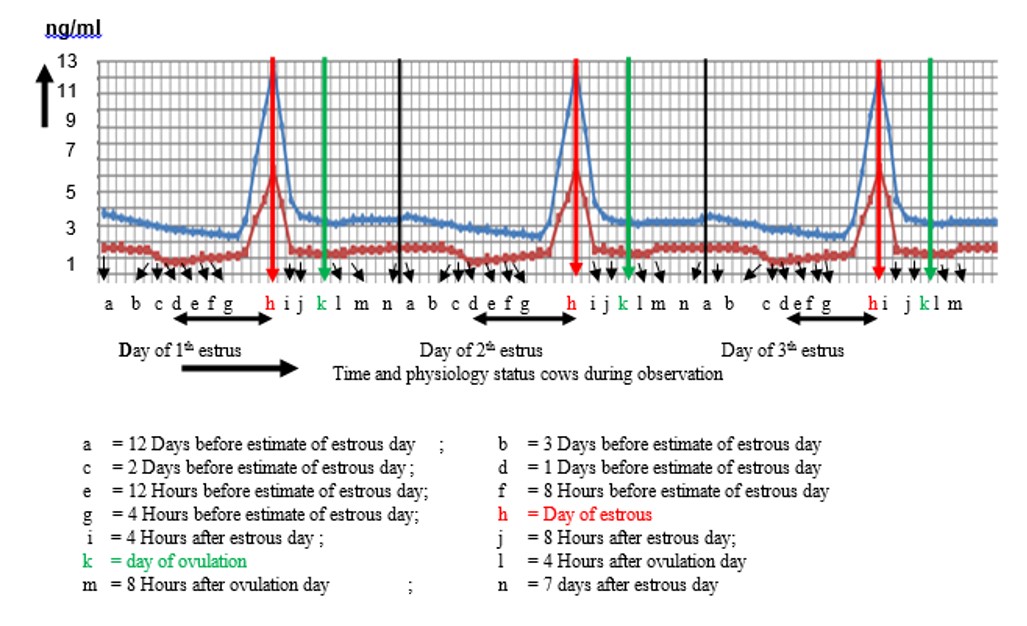Follicle Development and FSH Secretion Pattern of Ongole Crossbred Cow with Natural Twin Birth History
Aryogi1, Baliarti E2, Sumadi2, Kustono2
1Beef Cattle Research Station, Jl. Pahlawan, Grati - Pasuruan
E-mail: aryogia@gmail.com
2Faculty of Animal Science, Gadjah Mada University, Jl. Fauna 3 Bulaksumur Yogyakarta
(Diterima 19 Juli 2013 ; disetujui 23 Agustus 2013)
ABSTRAK
Aryogi, Baliarti E, Sumadi, Kustono. 2013. Perkembangan folikel dan pola sekresi fsh pada sapi induk peranakan Ongole yang beranak kembar secara alami. JITV18(3): 167-176. DOI: 10.14334/jitv.v18i3.318.
Penelitian bertujuan mendapatkan data dasar pengaruh sejarah beranak kembar secara alami terhadap reproduksi sapi PO induk, sebagai dasar pertimbangan menjawab kemungkinan penggunaan potensi genetik beranak kembar untuk meningkatkan produksi daging. Penelitian dilakukan selama tiga siklus estrus berturut-turut dan terdiri dari dua kegiatan. Kegiatan pertama dilakukan di Loka Penelitian Sapi Potong di kecamatan Grati, Kabupaten Pasuruan – Jawa Timur, mengamati jumlah dan perkembangan folikel sepuluh sapi induk sejarah beranak kembar secara alami (BK) dan sepuluh sapi induk dengan latar sejarah beranak tunggal (BT), menggunakan alat ultra sonography (USG). Kegiatan kedua di Loka Penelitian Sapi Potong dan di Fakultas Kedokteran Hewan Unair di Surabaya, mengamati profil konsentrasi sekresi FSH menggunakan kit Bovine Blood Serum serta metode IRMA pada lima sapi induk BK dan lima sapi induk BT. Data dianalisis menggunakan Chi-square test, t-test dan deskriptif. Hasil penelitian menunjukkan bahwa 23,33% induk BK dapat menghasilkan dua folikel dominan (de Graf) di suatu siklus estrusnya dan nyata (P < 0,01) mensekresikan konsentrasi FSH yang lebih tinggi (1,26 – 3,13 kali) dibandingkan dengan induk BT. Disimpulkan, sapi PO induk BK dapat menghasilkan lebih dari satu folikel dominan di suatu siklus estrusnya dan level konsentrasi sekresi FSH nya jauh lebih tinggi dibandingkan dengan induk BT.
Kata Kunci: Beranak Kembar, Sapi PO, Folikel, FSH
ABSTRACT
Aryogi, Baliarti E, Sumadi, Kustono. 2013. Follicle development and FSH secretion pattern of Ongole crossbred cow with natural twin birth history. JITV 18(3): 167-176. DOI: 10.14334/jitv.v18i3.318.
A research was done to obtain basic data about influence of natural twin birth history on reproduction of Ongole crossbred (PO) cow, as a basic consideration in utilizing twin genetic potency to increase beef production. The research was done for three estrus cycles respectively, and consists of two activities. The first activity was done in Beef Cattle Research Station (BCReS) at Grati sub-district, Pasuruan district – East Java, to observe number and development of follicle of ten cows with natural twin birth history (TP) and ten cows with single birth history (SP). In this activit ultra sonography (USG) equipment was used. The second activity was done in BCReS and in the Faculty of Veterinary Airlangga University at Surabaya, to observe concentration and profile of FSH using Bovine Blood Serum kit and IRMA method of five cows with TP and five PO cows with SP. Data obtained were analyzed using Chi-square test, t-test and descriptive presentation. Result shows that 23.33% of cows with TP produced two dominant (de Graf) follicles in an estrus cycle and significantly (P < 0.01) higher FSH secretion concentration (1.26 – 3.13 times) than that of cows with SP. It is concluded that PO cows with TP can produces more than one de Graf follicles in an estrus cycle and it has very high secretion concentration level of FSH.
Key Words: Twin Births, PO Cow, Follicle, FSH
INTRODUCTION
Twin births in cow can be defined as a phenomenon of giving birth to more than one calf of a cow. Natural twin births is an uncommon phenomenon for uniparous animals (Komisarek and Dorynek 2002) and is rarely happened (Montgomery 2000; de Rose and Wilton 2009). Moreover it is a result of interaction between genetic factors (Kirkpatrick 2002; de Rose and Wilton 2009) and environment effect (Komisarek and Dorynek 2002).
The expression of twin parturition genes are through arrangement of reproductive hormones secretion level such as follicle stimulating hormone or FSH (Leslie 2003) which then influences follicle development, number of dominant/de Graf/Graafian follicle and ovulated in an estrus cycle (Meuwissen et al. 2002). Environmental factor which gives the biggest influence towards twin birth gene expression is nutrient consumption (Karlsen et al. 2000; Kirkpatrick 2002; Komisarek and Dorynek 2002; Meuwissen et al. 2002).
Komisarek and Dorynek (2002) stated that, twin genetical cow that consume feed nutrients over needed will have an increasing metabolism activity, so that controlling twin birth genes stimulate hypothalamus pituitary in gland pituitary anterior part to produce and secrete FSH and LH above normal concentration; as consequence, growth, development, and maturation of more than one dominant/de Graf/Graafian follicle ovulation in an estrus cycle of cattle. If that particular cow is copulated, has fertilization, and embryos keep growing and developing until it is born, cow will get twin calves.
It is stated by Kojima (2003), that more than 90% of twin birth phenomena in cattle are non identical (more than one ovum are ovulated), so that several reproduction hormones play a big role in determining twin birth possibility. Over concentration of FSH play significant role during follicle development phase starting from primary follicle formation until mature follicle (Graafian follicle) is formed, even until ovulation happens (Arsian et al. 2003). Therefore, cow that will get twin need a strong influence of FSH through a high concentration so that there will be production of more than one Graafian follicles which are ready to ovulate (Leslie 2003).
Follicle stimulating hormone is a reproduction hormone of gonado-tropins group which is synthesized and secreted by gland pituitary anterior (Arsian et al. 2003). In every phase of estrus cycle, particularly before ovulation happens, a cow has fluctuating FSH concentration. Fluctuation is maintained through positive and negative feedback mechanism with other hormones (Atkins et al. 2010), whereas culminating point happens around estrus or a few time before ovulation (Britt, 2008). The main role of FSH is on folliculogenesis. Related to natural twin birth phenomenon, Atkins et al. (2010) said that because of FSH concentration increase very high since beginning of folliculogenesis (as result of a pressure towards estradiol concentration in blood), dominant follicles that will be ovulated are more than one.
Follicle is an anatomical structure of an ovarium basic unit (Findlay et al. 2009), deriving from growth and development of follicle primordial collection and containing oocyt and producing estrogen (Atkins et al. 2010). Process of follicle growth and development is known as folliculogenesis (Britt 2008) and is started since collection of primordial follicles (which are already in ovarium since cattle was born), until becomes Graafian follicle which is ready to be ovulated (Beg et al. 2002).
Folliculogenesis is result of several hormones, particularly FSH (Kojima 2003), in cows consists of 4 follicle development phases; those are primordial germ cells, primordial follicles, primary/secondary/tertiary follicle and Graafian follicle, and two development phases of ex-follicle; those are corpus luteum and corpus albicans (Britt 2008). Related to occurance of natural twin birth in cow, Lucy (2007) explained that existence of LH receptor earlier causes more than one dominant follicles (with smaller diameter), having LH receptor in its granule cells, so that it is avoided from atresia and becomes a physiological mechanism to make non identical twin parturitions happens. Meanwhile, Atkins et al. (2010) suggested that pressure towards estradiol concentration in blood also increases FSH concentration, so that it is sufficient to produce more than one de Graf follicles to ovulate.
The objectives of this research to investigate amount of dominant/de Graf/Graafian follicle produced, follicle development and FSH secretion pattern in an estrus cycle of Ongole crossbred cows with natural twin birth history. The benefits of this research, data of dominant/de Graf/Graafian follicle numbers and follicle development phases gives information from earlier to do identification and becomes an effort to optimize the opportunity of natural twin birth. Also, data about FSH secretion gives an initial description about the concentration of FSH which is needed, in case ones will arrange artificial twin birth using hormonal treatment.
MATERIALS AND METHOD
This study was divided into two research activities (A and B). Research activity A was identification of number and development of follicle, while activity B was identification of FSH profile, secretion level of Ongole crossbred cow with natural twin birth history, during three serial of naturally cycles estrus (without synchronization estrous treatment). Scheme of two identifications showed in Figure 1 and Table 1.
During research, cows with single calves were fed with 3.0% of its body weight (dry matter) and addition of 20% of 3.0% for cows with twin calves. Cows were fed 30% forage (50% grass and 50% rice straw) and 70% concentrate, contain 10% CP (iso protein) and 55% TDN. Data were analyzed using Chi-square test and t-test, also descriptive.

Figure1. Schedule of count number EF or dGF or CL, observations of follicular development and blood sampling collections
Table 1. Time, form and purpose of each observation points
Time of observations |
Activity |
Observations form |
Purpose of observations |
|
a |
12 days before estimate of estrous day |
A |
Measurement and calculation of EF |
1. prediction of estrous day |
2. development number of EF |
||||
B |
Collecting blood samples 1 time/day |
1. level hormone before estrous |
||
b |
3 days before estimate of estrous day |
A |
Measurement and calculation of EF |
Determine occur of estrus day |
development number of EF |
||||
B |
Collecting blood samples 1 time/day |
Level hormone before estrus |
||
c |
2 days before estimate of estrous day |
A |
Measurement and calculation of dGF |
Determine occur of estrus day |
development number of dGF |
||||
B |
Collecting blood samples 1 time/day |
Level hormone before estrus |
||
d |
1 days before estimate of estrous day |
A |
Measurement and calculation of dGF |
Determine occur of estrus day |
development number of dGF |
||||
B |
collecting blood samples 6 time/day |
Level hormone each 4 hours before E |
||
e |
Day of estrous occur (E) |
A |
Measurement and calculation of dGF/CL |
development number of dGF/CL |
B |
Collecting blood samples during 6 time/day |
Level hormone each 4 hours before during E |
||
f |
One day after estrous/day of ovulation (O) |
A |
Measurement and calculation of CL |
development number of CL |
B |
Collecting blood samples during O 6 time/day |
Level hormone each 4 hours during O |
||
g |
7 Day of estrous occur (E) |
A |
Measurement and calculation of CL |
development number of CL |
B |
Collecting blood samples after E, 1 times/day |
Level hormone after E |
Note : E = estrous ; O = ovulation ; EF = early follicle ; dGF = de Graf follicle ; CL = corpus luteum
Research activity A
The research was conducted in Beef Cattle Research Station (BCReS) at Grati in Pasuruan district, observation was done on number of dominant/de Graf/Graafian follicle and development follicle (using ultrasonography or USG, SIUI brand and type CTS-77 (Figure 2) of ten Ongole cross breed cows TP and ten Ongole cross breed cows SP. Age of cows based on teeth condition, were between I1 until I2.
Research activity B
The research was conducted in Beef Cattle Research Station (BCReS) at Grati in Pasuruan district and in Reproduction and Obstetric Department Laboratory Faculty of Veterinary Medicine University of Airlangga Surabaya. Observation was done on profile of FSH, secretion level (using Bovine Blood Serum kit with IRMA method) to five Ongole crossbred cows TP (1 cow with 2 dominant follicles in 3 times, 1 cow with 2 dominant follicles in 2 times, 2 cows with 2 dominant follicles in 1 time and 1 cow never have 2 dominant follicles in 3 times) and five Ongole croosbred cows SP, during 3 serial of estrus cycles.
Time for collecting blood samples were based on USG result that observe development of follicle (Figure 1 and Table 1), so it described fluctuation of FSH secretion level.

Figure 2. Observed number of dominant/de Graf/Graafian follicle and development follicle using ultrasonography (USG) tool
RESULTS AND DISCUSSION
Research activity A
Result on number of dominant follicle which is produced by cow (Table 2.), showed that there was only 4 of 10 heads or 7 of 30 times estrus cycle in cows with twin birth history (23.33% of observation number) produced two de Graf follicles in an estrus cycle. Chi-square test showed no significant relation (α = 0.05) between number of two de Graf follicles and estrus cycle. Komisarek and Dorynek (2002) said, frequency of twin birth on beef cattle is very low, like in Bos taurus in sub tropic area is less than 1% of its population. Genetic expression of twin birth in cattle is defined by epistatic gene expression. When gene phenotype of single birth is covered by gene phenotype of twin birth, there will be two follicle produced (Hartwell et al. 2008).
Observation of follicle development in cows with twin and single birth history show a similar result (Figure 3 and 4.). A difference lies on number of two follicles since secondary follicle period appears in ovary of cow with twin birth history. Different development of this follicle started with growth of two secondary follicles with similar size, then they begin to develop becoming two Graafian follicle, and both of them are ovulated at same period and create two
corpus luteum.
Table 2. Number of dominant follicle which is produced by cow during research
Parturitions history of cow |
No. |
Estrus 1th |
Estrus 2th |
Estrus 3th |
Freq. two foll/CL |
|||
L.Ov |
R.Ov |
L.Ov |
R.Ov |
L.Ov |
R.Ov |
|||
TP |
01 |
1 |
1 |
1 |
-- |
-- |
1 |
1 x |
02 |
1 |
1 |
-- |
1 |
1 |
1 |
2 x |
|
03 |
1 |
-- |
-- |
1 |
1 |
-- |
-- |
|
04 |
-- |
1 |
1 |
-- |
-- |
1 |
-- |
|
05 |
-- |
1 |
1 |
-- |
-- |
1 |
-- |
|
06 |
1 |
1 |
1 |
1 |
1 |
1 |
3 x |
|
07 |
1 |
-- |
1 |
1 |
1 |
-- |
1 x |
|
08 |
1 |
-- |
-- |
1 |
1 |
-- |
-- |
|
09 |
1 |
-- |
-- |
1 |
1 |
-- |
-- |
|
10 |
-- |
1 |
1 |
-- |
-- |
1 |
-- |
|
SP |
01 |
-- |
1 |
1 |
-- |
1 |
-- |
-- |
02 |
-- |
1 |
-- |
1 |
1 |
-- |
-- |
|
03 |
-- |
1 |
1 |
-- |
-- |
1 |
-- |
|
04 |
-- |
1 |
-- |
1 |
-- |
1 |
-- |
|
05 |
-- |
1 |
1 |
-- |
-- |
1 |
-- |
|
06 |
-- |
1 |
1 |
-- |
-- |
1 |
-- |
|
07 |
-- |
1 |
1 |
-- |
1 |
-- |
-- |
|
08 |
-- |
1 |
1 |
-- |
-- |
1 |
-- |
|
09 |
-- |
1 |
1 |
-- |
1 |
-- |
-- |
|
10 |
1 |
-- |
-- |
1 |
-- |
1 |
-- |
|
TP = Twin parturitions; SP = Single parturition; L.Ov = Left ovary; R.Ov.rg = Right ovary

Figure 3. Step of follicle developing in a cycle estrus at Ongole crossbred cows with twin parturitions history

Figure 4. Step of folicle developing in a cycle estrus at Ongole crossbred cows with single parturitions history
Research activity B
Influence of twin birth history cows toward FSH secretion level showed that secretion pattern of hormone in cows with twin or single birth history were similar (Figure 5), and it is similar to that reported by Leslie (2003) in Bos taurus with single birth history. There were difference among FSH secretion level in cows with twin birth history, it increases up to a high level (P < 0.01), it rised from 125.8 up to 313.3%, especially approaching and subsequent to estrus cycle. The FSH secretion level of cows with twin birth history was higher than cows with single birth history that always have one dominant follicle only. This research proves that most of twin phenomenon is not identical caused by effect of increasing hormone level, not by change on secretion pattern.
FSH is importantly needed for early primary follicle development and it is required for ovulation period (Kojima 2003) so a cow will need more FSH in order to produce more than one Graafian follicle. If FSH level of cow with single parturitions history (0.7 ± 0.1 until 6.5 ± 0.5 ng/ml) is considered as a level which is needed to produce one dominant follicle, so the research showed that FSH necessity to produce more than one de Graf follicles was 3.0 ± 0.1 until 15.7 ± 0.9 ng/ml. A research in Bos taurus which has twin birth history and approaching twin calves also find that FSH level increases beyond normal level, but still in normal level if cow birth single calf (Komisarek and Dorynek 2002).

Figure 5. Profile and FSH secretion level of Ongole cross breed cows with twin (blue) and single (red) parturitions history during 3 times estrus cycles
CONCLUSION
From the present research it is be concluded that Ongole cross breed cows with twin birth history could produce more than one de Graf follicles in an estrus cycle, because FSH increased its secretion level (especially in some hours of pre and post estrus).
REFERENCES
Arsian AA, Jacquotte AZ, Lukanova A, Rinaldi S, Kaaks R, Toniolo P. 2003. Reliability of FSH measurement in serum. Reprod Biol Endocrinol. 1:49. http://www.rbej.com/content/1/49.
Atkins JA, Smith MF, Smith, KJ, Wells, Geary TW. 2010. Factors affecting pre ovulatory follicle diameter and ovulation rate after gonadotropin releasing hormone in postpartum beef cows. Part II: Anestrous cows. J Anim Sci. 88:2311-2320.
Beg MA, Bergfelt DR, Kot K, Ginther OJ. 2002. Follicle selection in cattle: Dynamics of follicular fluid factors during development of follicle dominance. Biol Reprod. 66:120-126.
Britt JH. 2008. Oocyte development in cattle: physiological and genetic aspects. Revista Brasileira de Zootecnia. R Bras Zootec, v.37, suplemento especialp.110-115.
de Rose EP, Wilton JW. 2009. Productivity and profitability of twin births in beef cattle. J Anim Sci. 69:3085-3093.
Findlay JK, Kerr JB, Britt K, Liew SH, Simpson ER, Rosairo D, Drummond A, 2009. Ovarian physiology: follicle development, oocyte and hormone relationships. Anim Reprod. 6:16-19.
Hartwell LH, Hood L, Goldbery ML, Reynold AE, Silver LM, Veres RC. 2008. Genetic from genes to genomes. 3nd ed. New York: Mc Graw Hill Companies Inc.
Karlsen A, Ruane J, Klemetsdal G, Heringstad B. 2000. Twinning rate in Norwegian cattle: Frequency, (co)variance components and genetic trends.J Anim Sci. 78:15-20.
Kirkpatrick BW. 2002. Management of twinning cow herds.J Anim Sci. 80:E14-E18.
Kojima FN. 2003. The estrous cycle in cattle: Physiology, endocrinology and follicular waves. Prof Anim Sci. 19:83-95.
Komisarek J, Dorynek Z. 2002. Genetic aspects of twinning in cattle. Review article. J Appl Genet. 43:55-68.
Leslie KE. 2003. The events of normal and abnormal postpartum reproductive endocrinology and uterine involution in dairy cows: Can Vet J. 1983; 24:67-71. A Review. 6 November 2011.
Lucy MC. 2007.The bovine dominant ovarian follicle.J Anim Sci. 85:E89–E99.
Meuwissen TH, Karlsen A, Lien S, Olsaker I, Goddard ME. 2002. Fine mapping of a quantitative trait locus for twinning rate using combined linkage and linkage disequilibrium mapping. Genetics. 161:373-379.
Montgomery GW. 2000. Genome mapping in ruminants and map locations for genes influencing reproduction. Reviews of Reproduction.J Reprod Fertil. 5.1359.6004: 25-37. Brisbane, Australia.
TweetRefbacks
- There are currently no refbacks.

This work is licensed under a Creative Commons Attribution 4.0 International License.































